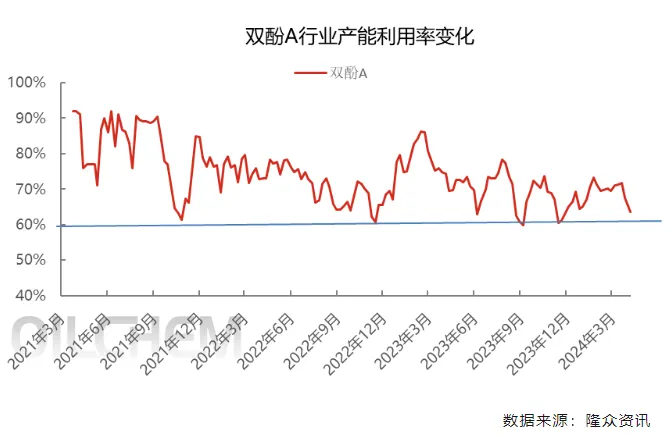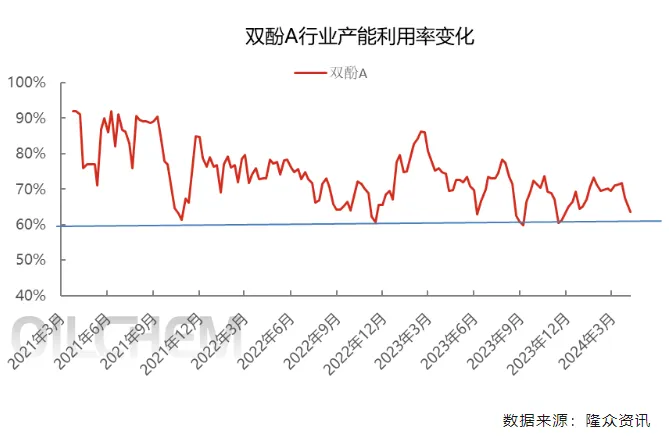1.ניתוח פעולות שוק
מאז אפריל, שוק הביספנול A המקומי הראה מגמת עלייה ברורה. מגמה זו נתמכת בעיקר על ידי עליית מחירי חומרי הגלם הכפולים פנול ואצטון. המחיר המצוטט במזרח סין עלה לכ-9500 יואן/טון. במקביל, התפעול הגבוה המתמשך של מחירי הנפט הגולמי מספק גם הוא מרחב עלייה לשוק הביספנול A. בהקשר זה, שוק הביספנול A הראה מגמת התאוששות.
2,הירידה בעומס הייצור והשפעת תחזוקת הציוד
לאחרונה, עומס הייצור של ביספנול A בסין ירד, וגם המחירים שצוינו על ידי היצרנים עלו בהתאם. מסוף מרץ ועד תחילת אפריל, מספר סגירות מפעלי ביספנול A מקומיים לצורך תחזוקה גדל, מה שהוביל למחסור זמני באספקה בשוק. בנוסף, עקב המצב הנוכחי של מפעלים מקומיים שמפסידים, קצב התפעול של התעשייה ירד לכ-60%, והגיע לשפל חדש בשישה חודשים. נכון ל-12 באפריל, כושר הייצור של מתקני חניה הגיע לכמעט מיליון טון, המהווים כ-20% מסך כושר הייצור המקומי. גורמים אלה יחד העלו את מחיר הביספנול A.
3.ביקוש איטי במורד הזרם מגביל את הצמיחה
למרות ששוק הביספנול A מראה מגמת עלייה, הירידה המתמשכת בביקוש במורד הזרם הגבילה את מגמת העלייה שלו. ביספנול A משמש בעיקר בייצור שרף אפוקסי ופוליקרבונט (PC), ושתי תעשיות במורד הזרם הללו מהוות כמעט 95% מסך כושר הייצור של ביספנול A. עם זאת, לאחרונה, קיימת תחושה חזקה של "המתנה וראייה" בשוק ה-PC במורד הזרם, וייתכן שהציוד יעבור תחזוקה מרכזית, מה שיביא לעלייה קלה בלבד בשוק. במקביל, גם שוק שרף האפוקסי מראה מגמה חלשה, שכן הביקוש הסופי הכולל איטי וקצב התפעול של מפעלי שרף האפוקסי נמוך, מה שמקשה על עמוד בקצב העלייה של ביספנול A. לכן, הביקוש הכולל לביספנול A במוצרים במורד הזרם הצטמק, והפך לגורם העיקרי המגביל את צמיחתו.
4,המצב הנוכחי והאתגרים של תעשיית הביספנול A בסין
מאז 2010, כושר הייצור של ביספנול A בסין גדל במהירות וכעת הוא הפך ליצרן ולספק הגדול בעולם של ביספנול A. עם זאת, עם הרחבת כושר הייצור, הדילמה של יישומים מרוכזים במורד הזרם הופכת בולטת יותר ויותר. כיום, חומרי גלם כימיים בסיסיים בכמויות גדולות ומוצרים כימיים בינוניים עד נמוכים נמצאים בדרך כלל במצב של עודף או עודף חמור. למרות הפוטנציאל העצום לביקוש לצריכה מקומית, כיצד לעודד את פוטנציאל שדרוג הצריכה ולקדם חדשנות ופיתוח בתעשייה הוא אתגר מרכזי העומד בפני תעשיית הביספנול A.
5,מגמות והזדמנויות פיתוח עתידיות
על מנת להתגבר על הדילמה של יישום מרוכז, תעשיית הביספנול A צריכה להגביר את מאמצי הפיתוח והייצור שלה במוצרים במורד הזרם כגון מעכבי בעירה וחומרים חדשים ממשפחת הפוליאתרימיד PEI. באמצעות חדשנות טכנולוגית ופיתוח מוצרים, להרחיב את תחומי היישום של ביספנול A ולשפר את התחרותיות שלו בשוק. במקביל, התעשייה צריכה לשים לב גם לשינויים בביקוש השוק ולהתאים את אסטרטגיות הייצור כדי להסתגל לשינויים בשוק.
לסיכום, למרות ששוק הביספנול A נתמך על ידי עליית מחירי חומרי הגלם והיצע מצומצם, הביקוש האיטי במורד הזרם עדיין מהווה גורם מפתח המגביל את צמיחתו. בעתיד, עם הרחבת כושר הייצור ואזורי היישום במורד הזרם, תעשיית הביספנול A תתמודד עם הזדמנויות ואתגרים חדשים לפיתוח. התעשייה צריכה לחדש כל הזמן ולהתאים אסטרטגיות כדי להסתגל לשינויים בשוק ולהשיג פיתוח בר-קיימא.
זמן פרסום: 15 באפריל 2024






